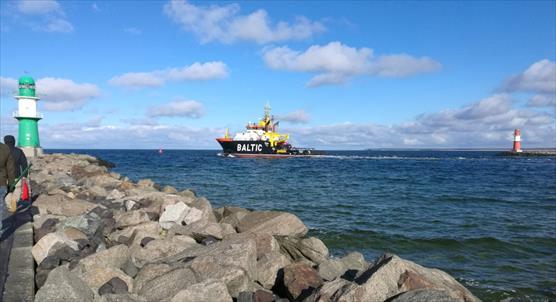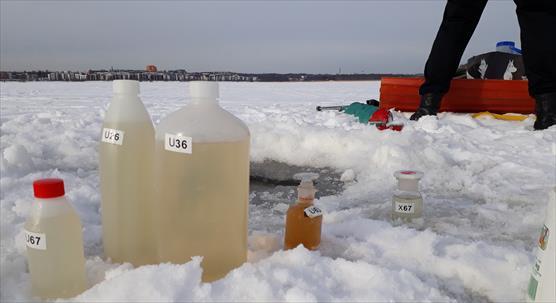Press release 2018-09-21 at 10:02

Estuary of the river Warnow in Warnemünde, Germany. © Photographer: Kuangxin Zhou
CWPharma, an EU-funded project, has started screening active pharmaceutical ingredients in six river basin districts to get a better picture of the sources, emissions and environmental concentrations of pharmaceuticals in the Baltic Sea region.
“We have already collected samples from six river basins and several wastewater treatment plants in Estonia, Finland, Germany, Latvia, Poland and Sweden. The aim of the screening is to estimate the overall pharmaceutical emissions in the Baltic Sea region,” says project manager Noora Perkola of the Finnish Environment Institute.
“We are currently analyzing the samples in our laboratories in Helsinki to screen approximately 80 active pharmaceutical ingredients. This is the first time such a wide screening will be made in a systematic way from varying samples and from various countries so that the results are truly comparable and can be used to get a good estimate of the emissions and potential hotspots.”
More information is needed about medicines and the environment
While pharmaceuticals are useful and sometimes life-saving for humans and domestic animals, they may be harmful for the environment. Helcom’s background report on pharmaceutical concentrations and effects in the Baltic Sea (2016) pointed out many knowledge gaps that exist in the Baltic Sea Region.
The CWPharma project aims to fill in many of those knowledge gaps. For instance, CWPharma will screen emissions from the pharmaceutical industry, hospitals, landfill sites, fish and poultry farms and municipal wastewater treatment plants.
“It is already known that medicines for human consumption can be found in the effluents of the wastewater treatment plants, and certain widely used pharmaceuticals, such as codeine, have also been found in Baltic fish. Nevertheless, very little is known in many areas about the amount of medicines leaking into the environment and even less is known about the effects of these substances on the environment.”
“Veterinary use of pharmaceuticals is an even bigger question. That is why we are also taking samples from waters near fish and poultry farms and from fields where manure has been used as a fertilizer.”

Water sampling in Finland started in winter 2018. The samples collected from various countries are now being analyzed for about 80 substances representing e.g. antibiotics, antihypertensives, non-steroidal anti-inflammatory drugs (NSAIDs), beta-blockers and lipid lowering agents. © Photographer: Katri Siimes / Finnish Environment Institute SYKE
How to reduce the emissions?
In addition to the screening of pharmaceuticals, CWPharma will evaluate different emission reduction measures, such as dissemination of environmental data on pharmaceutical products and granting of environmental permits to pharmaceutical plants. “Some of these measures are highly technical, like the advanced methods for wastewater treatment, but some are low-tech practices that can nevertheless make a big difference. These low-tech practices include, for instance, the take-back and disposal schemes for unused medicines,” Noora Perkola says.
The best existing practices of the partner countries will be shared in order to promote the sustainable management of pharmaceuticals in the Baltic Sea Region. For this purpose, the project will produce guidelines on advanced wastewater treatment, recommendations on low-tech practices to control and reduce the emissions, and an overall action plan for the best emission reduction measures.
More information
- Project Leader Noora Perkola, Finnish Environment Institute, tel. +358 295 251 507
- Leader of the Work Package 2 Emissions, Levels and Risks: Helene Ek Henning, County administrative board of Östergötland, tel. +46 (0)10 223 5000
-
-
CWPharma in a nutshell
- Duration: October 2017–September 2020
- The project consortium consists of 15 organizations from 7 Baltic countries (Denmark, Estonia, Finland, Germany, Latvia, Poland and Sweden). The work is coordinated by the Finnish Environment Institute SYKE.
- CWPharma is financed by the EU’s Interreg Baltic Sea Region Programme 2014–2020. The project is supported by the European Union´s Strategy for Baltic Sea Region Policy Area Hazards as an integrated part of the flagship on Pharmaceuticals in the Environment (PIE) – a Baltic Sea Region cooperation platform.
|
Photos for media use:
FOR_MEDIA_USE_Sampling_in_Finland_started_in_icy_conditions_in_winter_2018
Legend: Water sampling in Finland started in winter 2018. CWPharma has performed sampling in six river basin districts (Vantaa in Finland, Pärnu in Estonia, Lielupe and Daugava in Latvia, Vistula in Poland, Warnow-Peene in Germany and Motala ström in Sweden).
© Katri Siimes / Finnish Environment Institute
FOR_MEDIA_USE_Sampling_at_hospital_in_Linköping
Legend: Sampling at hospital in Linköping, Sweden. CWPharma will screen also emissions from pharmaceutical industry, hospitals, landfill sites, fish and poultry farms and municipal wastewater treatment plants.
© Helene Ek Henning / County administrative board of Östergötland
FOR_MEDIA_USE_Estuary_of_the_river_Warnow
Legend: The estuary of the river Warnow in Warnemünde is one of the sampling sites in Germany. All samples will be analyzed for about 80 substances representing e.g. antibiotics, antihypertensives, non-steroidal anti-inflammatory drugs (NSAIDs), beta-blockers and lipid lowering agents.
© Kuangxin Zhou / Kompetenzzentrum Wasser Berlin gGmbH